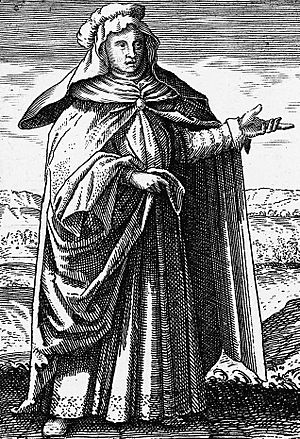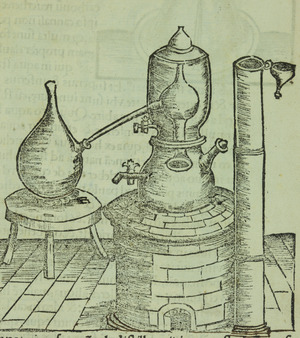Mary the Jewess facts for kids
Mary the Jewess (also called Maria the Prophetess) was a very early alchemist. She is known from the writings of Zosimos of Panopolis, who was a Gnostic Christian writer. Based on Zosimos's notes, she likely lived in Alexandria between the first and third centuries A.D.
Many experts, like Marilyn French and F. Sherwood Taylor, believe she was one of the first people to write about alchemy. They think her work dates back to at least the first century. She is famous for inventing several important tools used in chemistry. Many consider her the first true alchemist in the Western world.
Through Zosimos, we learn about Mary's ideas. She thought metals had qualities like bodies, souls, and spirits. Mary also believed metals had different "genders." She thought that by joining these different "gendered" substances, a new, unified substance could be created.
Contents
Her Story and Ideas
Who Was Mary the Jewess?
The main information we have about Mary the Jewess comes from Zosimos of Panopolis. He wrote the oldest known books on alchemy in the 4th century. Zosimos described many of Mary's experiments and tools. In his writings, he often spoke of Mary as someone who lived in the past. He called her "one of the sages," meaning a very wise person.
A writer from the 8th century, George Syncellus, said Mary was a teacher of Democritus. She supposedly met him in Memphis, Egypt, during the time of Pericles.
In the 10th century, a book called Kitāb al-Fihrist by Ibn al-Nadim listed Mary. It named her as one of the 52 most famous alchemists. The book also said she could make caput mortuum, which is a purple pigment or color.
An old alchemical text called her "Mary the Prophetess." Arab scholars knew her as the "Daughter of Plato." This name was later used for white sulfur in Western alchemy.
Mary's Writings and Sayings
None of Mary's original writings have survived to today. However, some of her quotes are found in other ancient texts. The most famous of these is in The Dialogue of Mary and Aros on the Magistery of Hermes. This text was put together by an unknown Christian philosopher.
This document describes early alchemical processes. These include leukosis (whitening) and xanthosis (yellowing). It also mentions acid salt and other acids for the first time. The text even includes recipes for making gold from plants, like mandragora.
Mary is also known for some mysterious alchemical sayings. She spoke about joining opposites:
Join the male and the female, and you will find what is sought.
Another famous saying is known as the Axiom of Maria:
One becomes two, two becomes three, and out of the third comes the one as the fourth.
Marie-Louise von Franz, who worked with psychologist Carl Jung, shared a slightly different version:
Out of the One comes Two, out of Two comes Three, and from the Third comes the One as the Fourth.
Carl Jung used this idea to explain the journey towards becoming a complete person.
Mary's Amazing Inventions
Mary, along with other ancient thinkers like Agathodaemon and Hermes Trismegistus, was mentioned by Zosimos of Panopolis. Zosimos described several devices that Mary helped create. These include the tribikos, the kerotakis, and the bain-marie. While her exact contributions are sometimes debated, these inventions are very important.
The Tribikos
The tribikos (which means "three-armed" in Greek) was a type of alembic. An alembic is a tool used to purify substances through distillation. It had three arms, which helped collect purified liquids. We don't know for sure if Mary invented it. However, Zosimos gave her credit for the first description of this instrument. Amazingly, similar distillation tools are still used in chemistry labs today!
In her writings (as quoted by Zosimos), Mary gave advice on making the tribikos. She suggested that the copper or bronze tubes should be as thick as a frying pan. She also said that the connections between the tubes and the main part of the still should be sealed tightly with a flour paste.
The Kerotakis
The kerotakis was a special device used to heat substances in alchemy. It also helped collect the vapors that came off. It was a sealed container with a copper sheet on top. When it worked correctly, all its connections formed a tight vacuum. Using such sealed containers in alchemy led to the phrase "hermetically sealed." This means something is completely airtight.
Alchemists believed the kerotakis copied how gold formed deep inside the Earth. This instrument was later changed by a German chemist named Franz von Soxhlet in 1879. He used its ideas to create the Soxhlet extractor, which is still used today.
The Bain-Marie
Mary's name lives on in her invention called the bain-marie. This French term means "Mary's bath." It's a clever way to heat something gently. It works by placing one container inside a larger one filled with water. The water in the outer container is heated, and this gentle heat then warms the inner container.
This method limits the temperature of the inner container to the boiling point of the water. It's very useful in chemistry when you need to heat things carefully. The bain-marie is also widely used in cooking, often called a double boiler. The term "bain-marie" was first used by Arnold of Villanova in the 14th century.
See also
 In Spanish: María la Judía para niños
In Spanish: María la Judía para niños



